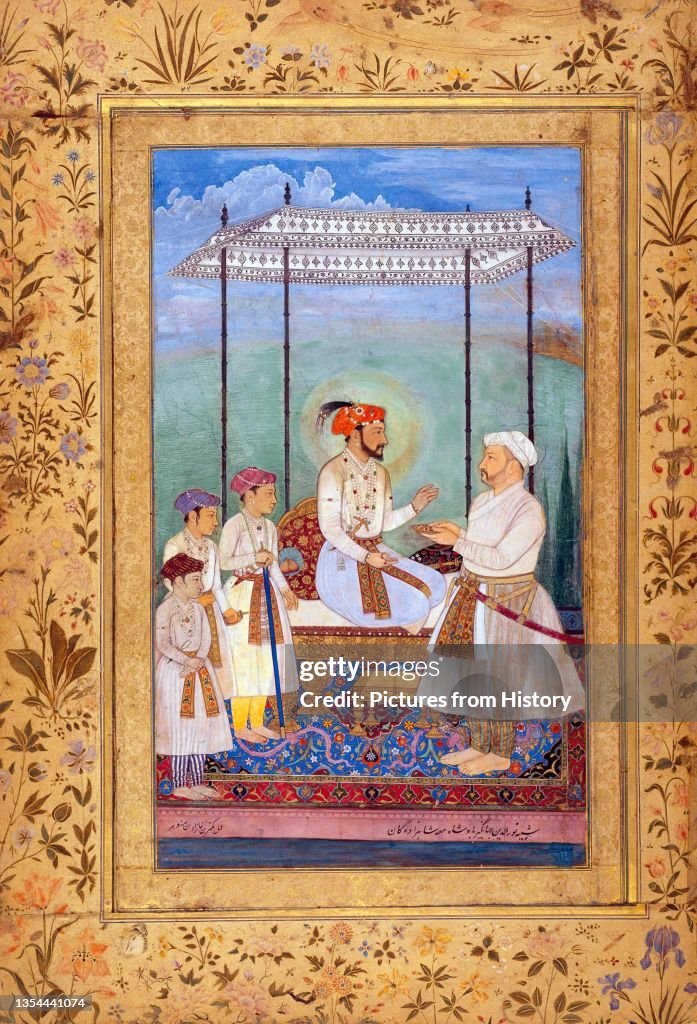India: Shah Jahan with his three young sons, Dara Shikoh, Shah Shuja and Aurangzeb, their maternal uncle Asaf Khan to the right. c. 1630
Shah Jahan (also spelled Shah Jehan, Shahjehan, Urdu: ___ _____, Persian: ___ ____) (January 5, 1592 Ð January 22, 1666) (Full title: His Imperial Majesty Al-Sultan al-'Azam wal Khaqan al-Mukarram, Malik-ul-Sultanat, Ala Hazrat Abu'l-Muzaffar Shahab ud-din Muhammad Shah Jahan I, Sahib-i-Qiran-i-Sani, Padshah Ghazi Zillu'llah, Firdaus-Ashiyani, ShahanshahÑE--Sultanant Ul Hindiya Wal Mughaliya, Emperor of India ) was the emperor of the Mughal Empire in the Indian Subcontinent from 1628 until 1658. The name Shah Jahan comes from Persian meaning 'King of the World'. He was the fifth Mughal emperor after Babur, Humayun, Akbar, and Jahangir. The period of his reign was the golden age of Mughal architecture. Shahanshah Shah Jahan erected many splendid monuments, the most famous of which is the legendary Taj Mahal at Agra built as a tomb for his wife, Empress Mumtaz Mahal. The Pearl Mosque and many other buildings in Agra, the Red Fort and the Jama Masjid Mosque in Delhi, mosques in Lahore, extensions to Lahore Fort and a mosque in Thatta also commemorate him. The famous Takht-e-Taus or the Peacock Throne, said to be worth millions of dollars by modern estimates, also dates from his reign. He was also the founder of the new imperial capital called Shahjahanabad, now known as Old Delhi. (Photo by: Pictures From History/Universal Images Group via Getty Images)

PURCHASE A LICENSE
How can I use this image?
$375.00
USD
Getty ImagesIndia: Shah Jahan with his three young sons, Dara Shikoh, Shah Shuja..., News Photo India: Shah Jahan with his three young sons, Dara Shikoh, Shah Shuja... Get premium, high resolution news photos at Getty ImagesProduct #:1354441074
India: Shah Jahan with his three young sons, Dara Shikoh, Shah Shuja... Get premium, high resolution news photos at Getty ImagesProduct #:1354441074
 India: Shah Jahan with his three young sons, Dara Shikoh, Shah Shuja... Get premium, high resolution news photos at Getty ImagesProduct #:1354441074
India: Shah Jahan with his three young sons, Dara Shikoh, Shah Shuja... Get premium, high resolution news photos at Getty ImagesProduct #:1354441074$499$175
Getty Images
In stockPlease note: images depicting historical events may contain themes, or have descriptions, that do not reflect current understanding. They are provided in a historical context. Learn more.
DETAILS
Restrictions:
Contact your local office for all commercial or promotional uses.
Credit:
Editorial #:
1354441074
Collection:
Universal Images Group
Date created:
February 01, 2010
Upload date:
License type:
Release info:
Not released. More information
Source:
Universal Images Group Editorial
Object name:
1060_05_cpa0011761
Max file size:
3450 x 5072 px (11.50 x 16.91 in) - 300 dpi - 6 MB